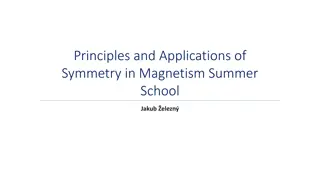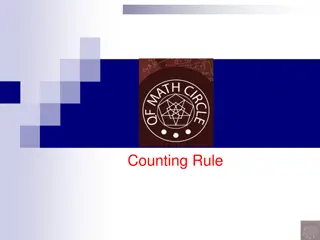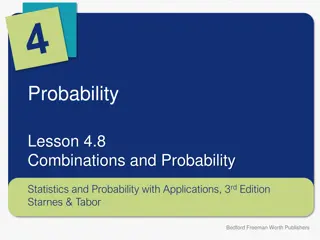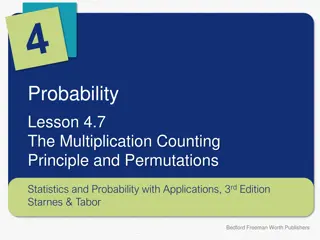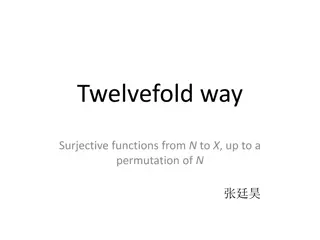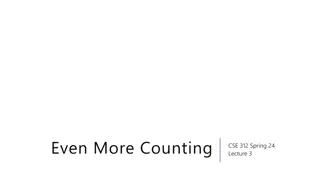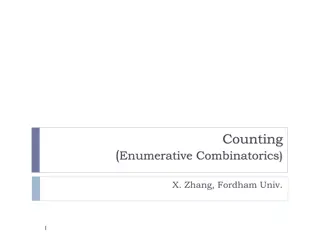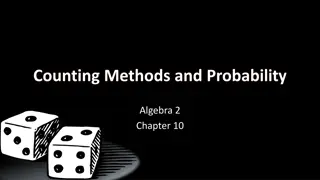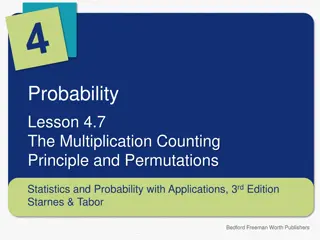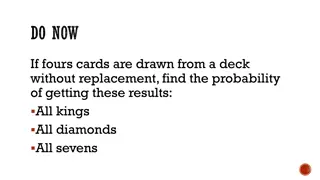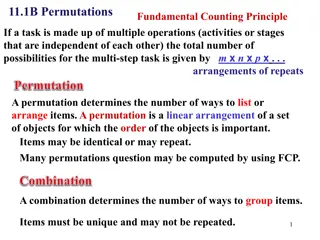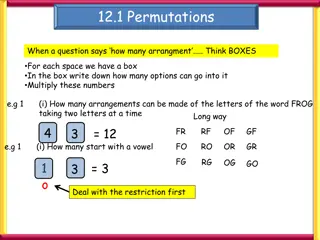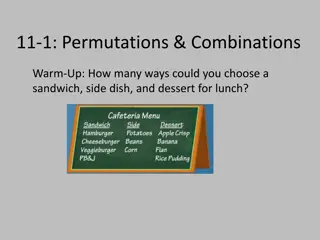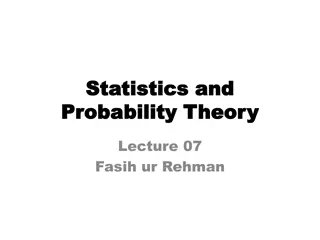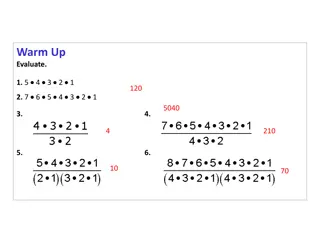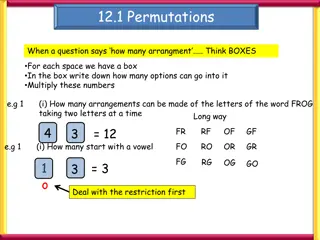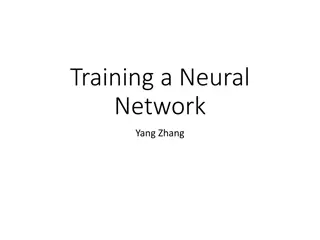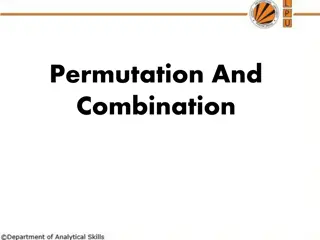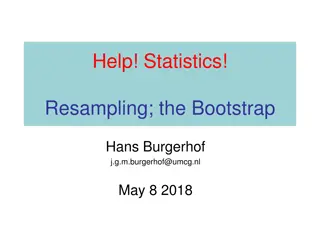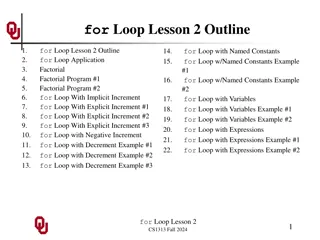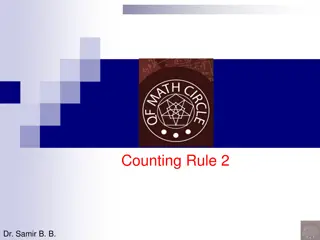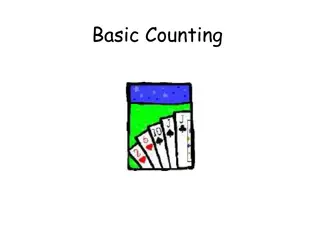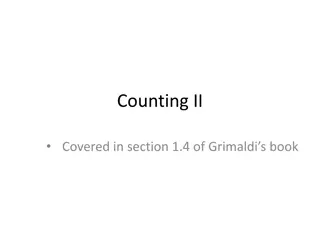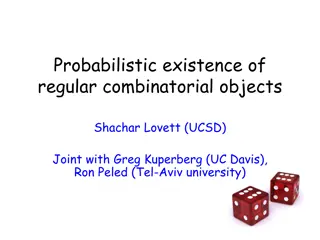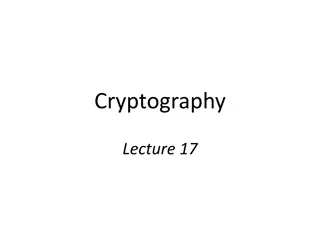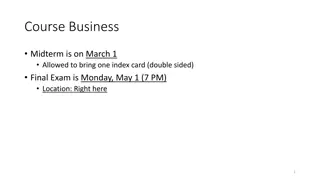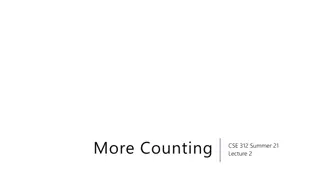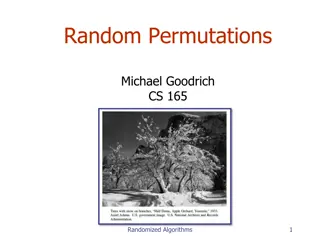Insights into Symmetry and Magnetism in Summer School Curriculum
Delve into the principles and applications of symmetry in magnetism through topics like tensor transformations, Edelstein effect, and breaking inversion symmetry in magnetic materials. Explore the role of crystal structures and interfaces in breaking symmetry, especially in antiferromagnets, providi
3 views • 39 slides
Counting Methods in Probability
This content provides an overview of counting methods for computing probabilities, including combinations and permutations with or without replacement. It explains concepts like permutation with replacement using examples, such as finding possible combinations of letters with repetition allowed. The
2 views • 30 slides
Permutations in Mathematics: Concepts and Examples
Permutations are arrangements of objects in a specific order, where the number of ways objects can be arranged is calculated based on distinct objects or objects with certain restrictions. Learn about the principles of permutations, the formula to determine permutations, and how to calculate them wi
2 views • 25 slides
Combinations and Probability in Statistics
Explore the concept of combinations and probability in statistics through lessons covering the computation of combinations, use of combinations to calculate probabilities, and application of the multiplication counting principle. Understand how to determine the number of different sets of selections
2 views • 17 slides
The Multiplication Counting Principle in Probability
The Multiplication Counting Principle and Permutations play a crucial role in determining the number of possible outcomes in various processes. This lesson covers how to use factorials to count permutations, compute arrangements of individuals, and apply the multiplication counting principle to dete
1 views • 14 slides
Exploring the Twelvefold Way in Combinatorics
The Twelvefold Way in combinatorics classifies enumerative problems related to finite sets, focusing on functions from set N to set X under various conditions like injective or surjective. It considers equivalence relations and orbits under group actions, providing a systematic approach to counting
4 views • 15 slides
Counting Techniques and Combinatorics Overview
Explanation of counting principles in combinatorics including permutations, combinations, binomial theorem, and overcounting scenarios with examples like anagrams. Also covers important facts and rules related to combinations. Highlights the importance of starting homework early and accessing option
0 views • 35 slides
Counting Strategies and Examples in Enumerative Combinatorics
Understanding counting principles in enumerative combinatorics is essential for solving mathematical problems involving permutations and combinations. The concepts discussed include calculating probabilities, determining the number of outcomes, and applying counting rules to various scenarios such a
1 views • 69 slides
Algebra 2 Chapter 10: Counting Principles and Permutations
Explore the fundamental counting principle and permutations in Algebra 2 Chapter 10. Understand how to calculate the number of ways events can happen and arrange objects. Learn about selecting ice cream sundaes, meal combinations, ordering objects, completing homework assignments, and reading book o
1 views • 46 slides
The Multiplication Counting Principle in Probability: Exploring Permutations
Exploring the multiplication counting principle in probability, this lesson delves into determining the number of ways to complete a process involving multiple steps. Using factorials for permutations, the content showcases how to compute permutations of individuals taken at a time. Through examples
0 views • 20 slides
Counting Rules and Probability in Mathematics
The content delves into fundamental counting rules such as the Fundamental Counting Rule, Permutation Rule, and Combination Rule to help determine the number of possible outcomes for sequences of events. Factorial notation and permutations are also explained, along with examples to illustrate their
0 views • 24 slides
Permutations in Mathematics
Permutations in mathematics involve arranging items in a specific order, considering factors like repetitions and groupings. Different scenarios are explored, such as selecting friends for lunch, arranging letters in words, and creating lists of favorite books. Formulas and strategies for calculatin
0 views • 14 slides
Permutations Explained with Examples in Mathematics
Learn how to calculate arrangements and codes using permutations by understanding the principles of combinations and restrictions. Explore various scenarios such as letter arrangements, digit codes, and number formations along with specific conditions like starting with vowels or meeting certain cri
0 views • 8 slides
Secure PRFs and PRPs in Cryptography
Dive into the world of secure Pseudo-Random Functions (PRFs) and Pseudo-Random Permutations (PRPs) in cryptography. Learn about the definitions, security criteria, and examples of secure PRFs and PRPs such as 3DES and AES. Explore the concepts of secure block ciphers and key principles behind these
0 views • 54 slides
Solving N-Queen Problem Using Genetic Algorithm
Solving the N-Queen problem involves placing queens on a chessboard in such a way that they cannot check each other. The genetic algorithm approach addresses this problem through representations like phenotype and genotype, fitness evaluation based on queen penalties, mutations involving permutation
0 views • 8 slides
Permutations and Combinations Problem Set
Explore various permutations and combinations scenarios involving arranging items in a particular order or selecting items where order does not matter. Topics covered include choosing lunch items, possible license plate combinations, arranging shirts in a closet, selecting students for presentations
0 views • 6 slides
Closest Points and Convex Hull in Divide and Conquer Algorithms
Exploring the divide-and-conquer approach to solving problems like finding the minimum distance between points on an xy-plane, and understanding concepts such as Gray Code and Hamiltonian Cycles in algorithm design. Dive into lexicographic permutations, efficient calculations, and examples seen in c
1 views • 16 slides
Introduction to Probability Theory with Examples and Permutations
Explore the fundamental concepts of probability theory through examples such as dice outcomes, home styling choices, and computer part ordering. Delve into permutations to understand arrangements of objects and calculations of possible selections. Learn about the number of permutations, distinct obj
0 views • 15 slides
Fundamental Counting Principle and Permutations in Mathematics
Explore the concept of the Fundamental Counting Principle through examples involving creating yogurt parfaits and generating passwords. Dive into permutations with scenarios like selecting student government officials. Visual aids and step-by-step explanations bring clarity to these mathematical con
2 views • 20 slides
Permutations in Mathematics Explained with Examples
Understand permutations in mathematics by visualizing arrangements as boxes with boxes representing spaces for different options. Learn how to calculate the number of arrangements by multiplying the options in each box. Explore examples involving letters, digits, and codes, dealing with various rest
1 views • 8 slides
Neural Network Training and Structure
This text delves into training a neural network, covering concepts such as weight space symmetries, error back-propagation, and ways to improve convergence. It also discusses the layer structures and notation of a neural network, emphasizing the importance of finding optimal sets of weights and offs
0 views • 31 slides
Permutations and Combinations in Mathematics
Permutations and combinations are fundamental concepts in mathematics that test logical reasoning and problem-solving skills. This article covers the basics of permutations, combinations, factorial, fundamental counting principles, and example questions to help you grasp these concepts effectively.
1 views • 86 slides
Resampling Techniques in Statistics
Explore the concept of resampling through methods like the Bootstrap, permutations, combinations, and parametric inferential statistics. Discover how resampling offers robust and relevant insights, and when to use it. Delve into the basics of permutations and combinations, and learn how to apply the
0 views • 35 slides
Factorial and Permutations with For Loop in C
Learn about the concept of factorial, permutations, and how they are calculated using a for loop in C programming. Explore different examples and programs to understand the application of for loops in calculating the number of orders in a line of students waiting for tickets.
1 views • 22 slides
Counting Methods: Combinations and Permutations
This content discusses various counting methods for computing probabilities, focusing on combinations and permutations. It explains the concepts of combinations (order doesn't matter) and permutations (order matters) with examples of selection and arrangement scenarios. The distinction between with
1 views • 37 slides
Fundamentals of Counting Principles in Mathematics
In this lecture, we delve into basic rules for counting, including the sum rule, product rule, generalized product rule, permutations, combinations, binomial coefficients, and combinatorial proofs. We also explore the inclusion-exclusion principle with practical examples such as determining total en
0 views • 51 slides
Permutations with Indistinguishable Objects
Permutations of objects where some items are indistinguishable can be solved using different methods. One example includes reordering the letters of a word like "JESSEE." By identifying the distinct letters and applying combinatorial calculations, the number of unique permutations can be determined
0 views • 72 slides
Probabilistic Existence of Regular Combinatorial Objects
Shachar Lovett from UCSD, along with Greg Kuperberg from UC Davis, and Ron Peled from Tel-Aviv University, explore the probabilistic existence of regular combinatorial objects like regular graphs, hyper-graphs, and k-wise permutations. They introduce novel probabilistic approaches to prove the exist
0 views • 46 slides
Independence and Counting in Probability
Explore the concepts of independence, pairwise independence, common misconceptions, and counting principles in probability theory. Learn about permutations, combinations, and how to calculate possible outcomes in different scenarios.
0 views • 8 slides
Counting Principles and Permutations
This content provides an overview of counting principles, permutations, and formulae for calculating permutations. Examples and solutions are included to illustrate the application of these concepts in solving counting problems.
0 views • 30 slides
Cryptography
This content provides an overview of Feistel networks and Data Encryption Standard (DES). It explains the construction of Feistel networks with invertible permutations, security aspects, and details about DES including its structure, key schedule, mangler function, S-boxes, and avalanche effect.
0 views • 22 slides
Practical Cryptography Topics: AES and Substitution Permutation Networks
Dive into the world of practical cryptography with insights into the Advanced Encryption Standard (AES) and Substitution Permutation Networks. Explore the history of AES, its design principles, key sizes, and basic operations like AddRoundKey, SubBytes, ShiftRows, and MixColumns. Understand the sign
1 views • 24 slides
More Counting
Announcements for CSE 312 Summer Lecture 2 with topics on permutations, combinations, and the binomial theorem. Explore sequential processes, factorial concepts, and dense questions in combinatorics. Understand the importance of order, distinct elements, and the universe of allowed elements in count
0 views • 44 slides
Permutations and Combinations in Mathematical Statistics
Permutations and combinations in mathematics, focusing on arrangements and groups formation of distinguishable objects. Learn the concepts symbolically and understand the difference between permutations and combinations for n distinguishable objects taken r at a time.
0 views • 14 slides
Complete Implementation: Card Class & Efficient Deck Shuffling Algorithm
Implement a Card class in Java with specified methods and test with CardTester. Learn about efficient deck shuffling algorithm strategies for equal permutations. Explore practical coding practices in Java.
0 views • 12 slides
Sparse Matrix Algorithms: Permutations and Chordal Completion
Most coefficients in matrices are zero, leading to sparsity. Sparse Gaussian elimination and chordal completion aim to minimize edges while solving matrices efficiently. The 2D model problem illustrates behaviors of sparse matrix algorithms. Permutations impact fill levels, with natural and nested d
0 views • 29 slides
Cryptanalysis and Rail Fence Cipher Decryption Methods
In this discussion, we explored cryptanalysis techniques and the decryption process of the rail fence cipher. By mapping text to random letter permutations, breaking ciphers through histograms, and analyzing letter frequency distributions, we delved into deciphering encrypted messages. The session h
0 views • 27 slides
Statistical Inference: Sampling, Permutations, and Probability
Delve into sampling without replacement, permutations, combinations, independence, and conditional probability in the realm of statistical inference with practical examples and solutions.
0 views • 7 slides
Discrete Structures: Permutations and Combinations
The concepts of permutations and combinations in the realm of discrete structures, unraveling the use of factorial in both scenarios. Dive into examples like rolling a die and flipping a coin, arranging letters, and solving combinations involving lock codes. Discover the formulas and methods behind
0 views • 64 slides
Understanding Randomized Algorithms for Generating Random Permutations
Explore the concept of random permutations in computer science, including random sort algorithms, Fisher-Yates shuffling, and analysis of permutation probabilities. Discover how randomized algorithms play a crucial role in various applications, such as card games and efficient algorithm design.
0 views • 7 slides
